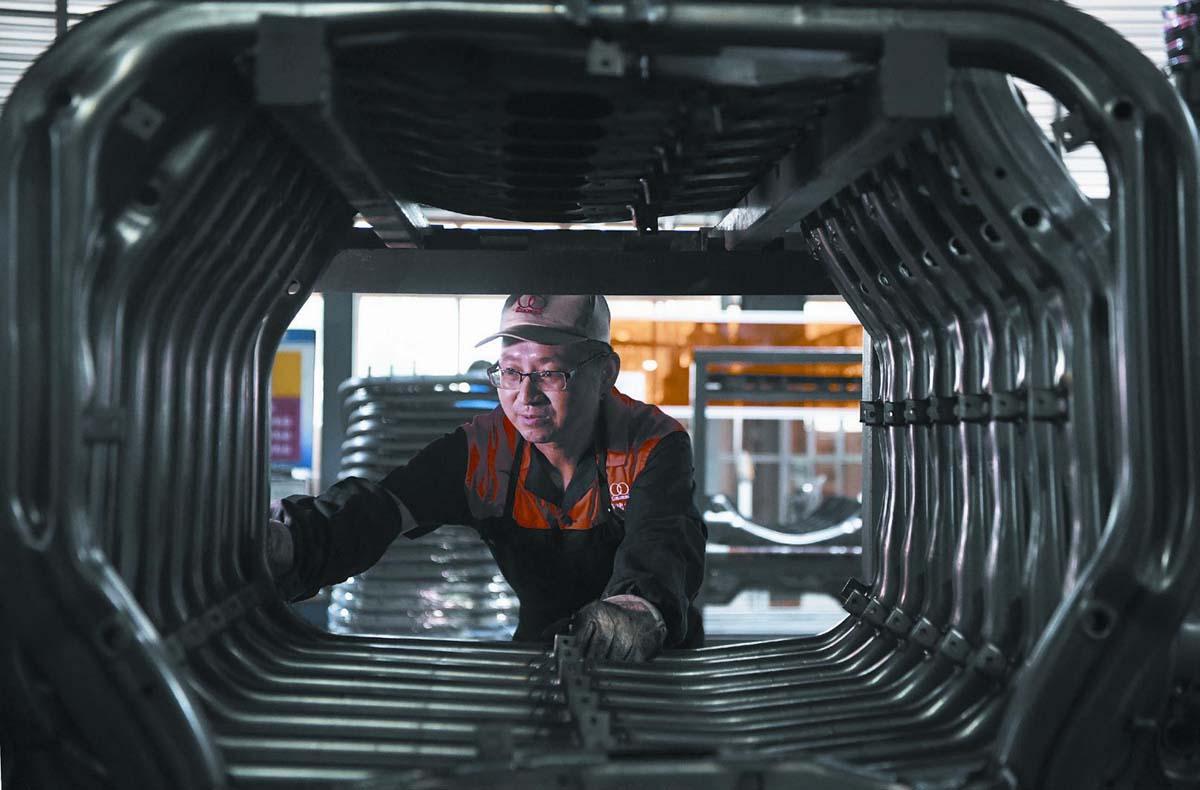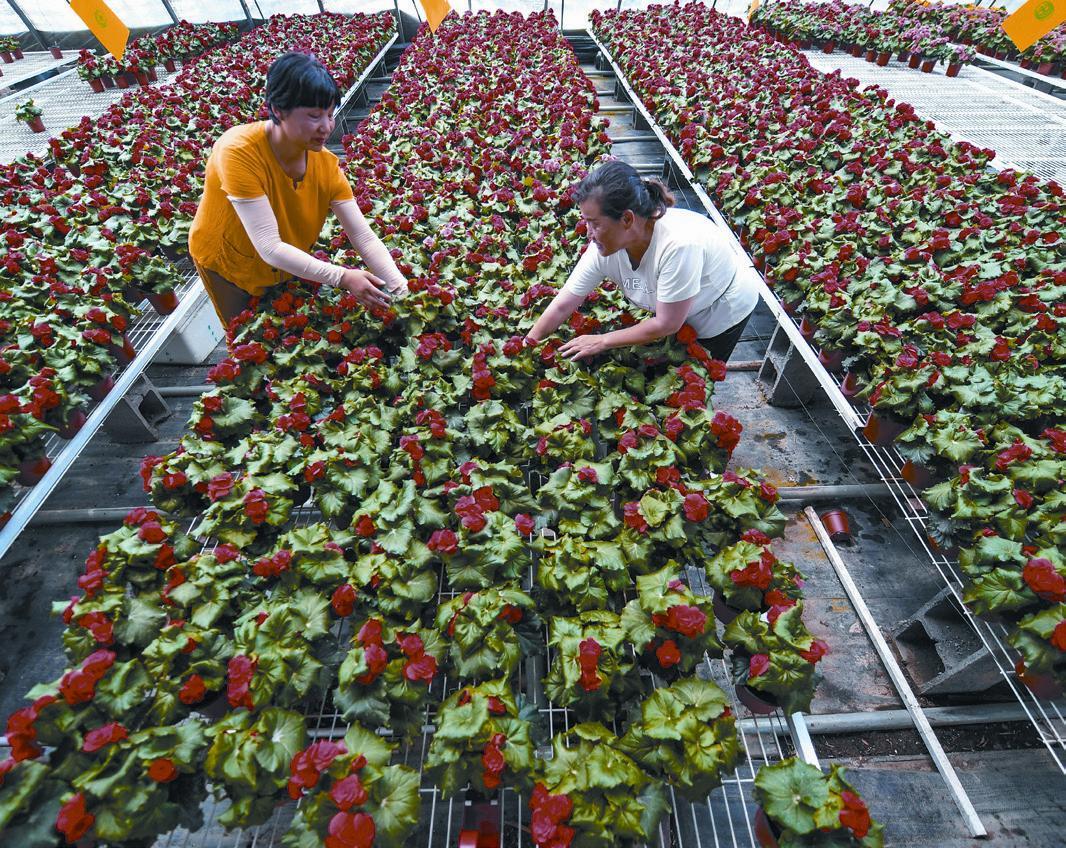High Above Sea Level
2019-08-06

High Above Sea Level
Tourists visit an aquarium in Xining, northwest Chinas Qinghai Province, which opened for trial operation on July 18. At an altitude of more than 2,200 meters above the sea level, the aquarium is the worlds highest and fi rst on the Qinghai-Tibet Plateau.
R&D Strength
A total of 4.19 million people in China worked in research and development (R&D) in 2018, maintaining the worlds largest pool of R&D personnel for six consecutive years, the National Bureau of Statistics(NBS) said on July 23.
Chinas R&D spending was 1.97 trillion yuan ($286 billion) in 2018, 138 times the amount in 1991, according to an NBS report.
It showed that the countrys R&D spending accounted for 2.18 percent of its GDP, reaching the worlds No.2 position after the United States.
The number of patent applications rose to 4.32 million in 2018, 86 times the number in 1991, said the report.
According to the 13th FiveYear Plan for National Science and Technology Talent Development(2016-20), China will increase its annual per-capita spending for R&D personnel to 500,000 yuan($72,688) by 2020, up from 370,000 yuan ($53,789) in 2014.
IP Center
A national center has been established to offer guidance to Chinese entities on resolving overseas intellectual property (IP) disputes, the industry watchdog said on July 24.
The launch of the center was part of efforts to enhance the mechanism to deal with overseas IP disputes, said Zhao Gang, deputy head of the National Intellectual Property Administration (NIPA), at a press conference.
In addition to guiding and serving Chinese enterprises in safeguarding their IP rights overseas, the center will also help them better understand and respect the IP systems and rules of overseas jurisdictions.
It will also focus on constructing information collection and distribution channels of overseas IP disputes at the national level, and establishing a guidance and coordination mechanism for handling overseas IP disputes for Chinese enterprises.
Once in full operation, the center will provide services through the Internet, a hotline and at its offi ces, senior NIPA offi cial Zhang Zhicheng said.
In the fi rst half of this year, foreign patent applications in China grew 8.6 percent and trademarks 15.4 percent, according to Zhao.
Easier Entry-Exit
Twelve measures were announced on July 17 to make immigration and entry-exit applications easier and more convenient for some foreigners. The Ministry of Public Security(MPS) said the facilitation measures were part of the fi rst batch of 60 special policies for promoting economic and social development and benefi ting the public and enterprises.
Starting on August 1, the country will ease the permanent residence application for more high-level foreign talent, including foreigners with doctoral degrees and those who have made signifi cant contributions to the country, according to an MPS press conference in Beijing.
Foreign spouses and children of qualifi ed foreigners can apply simultaneously, according to the MPS.
Those who are invited by universities, scientifi c research institutes or renowned enterprises for technological cooperation will be able to get visas or residence permits valid for two to fi ve years.
In recent years, China has issued 133,000 visas and residence permits to foreign entrepreneurs, investors, and technical and management specialists, said Chen Bin, an offi cial with the National Immigration Administration (NIA), at the press conference.
China is considering setting up immigration affairs service centers or stations in areas with a large population of foreigners to make their work, study and living more convenient.
Jia Tongbin, Deputy Director of the NIAs Foreigner Management Division, said the policy package is aimed at drawing overseas management and technology specialists who are in urgent need in China.
Smoke-Free Plan
Over 80 percent of Chinas population will be under smoke-free legal protection as of 2030, according to an action plan to implement the Healthy China initiative and promote peoples health.
Communist Party of China and government branches at all levels will become smoke-free, and smoking will be gradually banned throughout indoor public spaces, workplaces and public transport, it said.
Currently, there are over 300 million smokers in China, and over 1 million people die of smoke-related diseases annually.
As of the end of 2018, Beijing, Shanghai, Shenzhen in the southern province of Guangdong and Xian in the northwestern province of Shaanxi had banned smoking in indoor public spaces.
To The Rescue
Rescue workers gear up after a landslide hit a village in Shuicheng County, southwest Chinas Guizhou Province, on July 23. As of July 26, 20 people were found dead.

Mandarin Campaign
A campaign to promote standard Mandarin nationwide will be conducted from September 16 to 22, said the Ministry of Education in a circular on July 21.
Launched in 1998, the weeklong annual campaign aims to boost peoples awareness of the value of Chinese culture and enhance the role of language in passing it down.
It is also meant to further the use of Mandarin in the countrys impoverished areas and lift the language barriers impeding poverty alleviation, according to the circular.
In addition to traditional promotional means such as handing out fl yers and putting up posters, more efforts will be made to promote Mandarin through online channels and social media this year.
Fitness Promotion
Sports facilities including a standard basketball court and two table tennis tables will be available in villages across China, in an effort to promote fi tness for all.
Nearly 570,000 villages throughout the country currently have access to such facilities, but the remaining 50,000 are not covered yet by the program, said Lang Wei, an offi cial with the General Administration of Sport.
According to a recently unveiled action plan to implement the Healthy China initiative, the per-capita area dedicated to sports venues will reach 1.9 and 2.3 square meters by 2022 and 2030, respectively.
The action plan also proposes 6,000-10,000 footsteps of walking or running as the recommended amount of daily exercise, and encourages the public to include more physical activities in their daily life.
Little Performer
A Chinese student performs Peking Opera during the 2019 China-ASEAN Education Cooperation Week in Guiyang, capital of southwest Chinas Guizhou Province, on July 22.

Soccer in Schools
Notable progress has been made in promoting soccer in schools through enhanced training, more school matches and upgraded facilities, an education offi cial said at a press conference on July 23.
Currently, there are 24,126 primary and middle schools across the country serving as soccer specialist schools to spearhead youth soccer development, said Wang Dengfeng, a senior offi cial with the Ministry of Education (MOE).
The schools are required to offer at least one soccer class per week and encourage their students to participate in training and competitions, Wang said.
China aims to have 50,000 schools specializing in youth soccer by the end of 2025, said Wang, adding that the MOE plans to build more school soccer fi elds, train more coaches and provide extra funding and policy support.
In the past four years, local education departments have trained about 40,000 soccer teachers and 8,000 of them have obtained coaching certifi cates.
By September of last year, schools across the country had about 120,000 soccer fi elds of all sizes. From 2015 to 2018, the country built and upgraded about 32,000 fi elds in schools and plans to add 29,000 more by 2020, according to Wang.
In addition, outstanding players will also have the chance to join interschool teams for regional competitions and national summer camps.
This year over 8,000 students, 2,000 coaches and 200 experts from home and abroad are taking part in a two-month national summer camp which kicked off on July 14, Wang said.
The country has stepped up its efforts to promote soccer in schools since it set up a seven-department joint task force, including the education, sports and fi nance authorities and the Chinese Football Association, in 2015.
Rebalancing Progress
The economy moved a step forward in external rebalancing with the current account surplus plunging from more than 10 percent of the GDP in 2007 to 0.4 percent in 2018.
The substantial decline can be attributed to shrinking trade balance driven by high import growth and an increase in services defi cit, mostly driven by tourism, as well as higher commodity and semiconductor prices, according to a report released by the International Monetary Fund (IMF).
Sun Xuegong, Director of the Institute of Economic Research of the National Development and Reform Commission, said the reduction means the economy has become more reliant on domestic demand, rather than external factors.
“In an overall perspective, the current account surplus decline is conducive to the stability of the macroeconomy as a more domestic demand-driven economy has fewer fl uctuations and therefore more control over the whole picture,” Sun said.
The IMF expects the current account surplus to decline further over the next few years, in line with Chinas continued rebalancing.
However, it remains important to ensure that the rebalancing continues in order to avoid a return of excessive current account surpluses, the report said.
Chief IMF economist Gita Gopinath said the continued narrowing of Chinas current account surplus was a noteworthy development. Countries which run large current account surpluses may be saving too much and therefore can be detrimental to global demand, she added.
Therefore, it is important for China to continue its pivot toward more domestic demand-driven growth to ensure that there is less reliance on credit boom-driven growth and work on encouraging the private sector, Gopinath said.
Vehicle of Growth
A staff works in an automated production workshop of a car part company in southwest Chinas Chongqing on July 15. The city has supported local small and medium-sized enterprises to shift toward smart manufacturing, improving their competitiveness and contributing to high-quality growth.

Coffee Expansion
Chinese coffee chain brand Luckin Coffee has set its sights on global expansion by planning businesses in the Greater Middle East and India markets via a partnership.
Luckin and Americana Group, the largest integrated food product company in the Middle East, signed a memorandum of understanding on July 22. It includes a plan to set up a joint venture to launch new retail coffee businesses in these regions.
Founded in 2017, Luckin posted fast expansion thanks to its convenient tech-driven services and affordable products. It now operates over 3,000 stores across 40 cities in China.
The company plans to open more than 4,500 stores by the end of 2019 to become Chinas largest coffee chain.
Safety Assessment
A guideline on assessing the safety of cloud computing services has been issued by the Cyberspace Administration of China, National Development and Reform Commission, Ministry of Industry and Information Technology and Ministry of Finance to make cloud computing services safer for Communist Party of China users, government organs and key information infrastructure operators.
The safety assessment focuses on the credibility of cloud platform operators and their operation, the background of the staff of cloud service providers and the safety of cloud platforms supply chains.
Cloud service providers can offi cially submit applications for cloud computing service safety assessment from September 1. The assessment results will be valid for up to three years.
Vehicle Exports
A ceremony was held in north Chinas Tianjin on July 22, marking the export of 60 second-hand commercial vehicles, the fi rst batch of used commercial vehicles to be exported from China.
Having completed customs clearance in Tianjin, the vehicles, with a total value of over $700,000, will go from the Dongjiang Free Trade Port Zone in Tianjin to Apapa Quays, the largest port in Nigeria.
The second-hand automobile export business is accelerating the circulation of used automobiles, stimulating the domestic auto market vitality and deepening trade and economic exchanges with countries participating in the Belt and Road, according to the Tianjin Commission of Commerce.
The Dongjiang Port will be built into the largest used vehicle export base in north China, according to Shen Lei, Director of the Management Committee of the Dongjiang Free Trade Port Zone.
China began piloting the second-hand automobile export business in May, with Beijing, Tianjin, Shanghai and Guangdong Province in the south among the fi rst batch of pilot regions.
Trading Starts
Chinas sci-tech innovation board starts trading on the Shanghai Stock Exchange on July 22, with the fi rst batch of 25 companies debuting on the board. Proposed in November 2018, the new board will provide direct fi nancing support for companies in hi-tech and strategic emerging sectors.

Transport Boost
The transport sector saw rising investment and shrinking costs in the fi rst half of the year, the Ministry of Transport spokesperson said on July 24.
A total of 1.37 trillion yuan($199.68 billion) was invested in railways, highways, shipping and civil aviation in the fi rst six months of the year, up 4.8 percent from the same period last year.
Logistics costs and other related expenses shrank by about 63.37 billion yuan ($9.2 billion).
The January-June period also saw 8.75 billion passenger trips completed, down 1.8 percent over the same period last year. In terms of freight transportation, 24.58 billion tons of commercial freight was handled, up 5.9 percent. Railway freight volume rose 100 million tons year on year.
Besides, 135,000 km of rural roads were rebuilt or renovated, equivalent to 67.7 percent of the annual target.
On the Right Track
Farmers pick fl owers in Shengli Village, north Chinas Hebei Province, on July 18. The village has developed fl oriculture to improve local farmers income.

Pension System
To walk a fi ne line between lowering corporate burdens to boost economic growth and making the pension scheme more sustainable amid an aging population, the government has vowed to roll out a nationwide pilot program. Announced in 2017, it transfers stakes in state-owned fi rms to social security funds.
This comes as a 2-trillionyuan ($291.55 billion) reduction of tax burdens and social insurance contributions of enterprises helped lower corporate burdens but raised concerns over the sustainability of the pension system. To ease the pressure of pension payments, the government is trying to expand the resources of its pension funds.
The plan will see social security funds directly hold more shares in state-owned enterprises, allowing the funds to benefi t from dividends generated by government-owned assets.
Large and medium-sized state-owned and state-controlled enterprises at both central and provincial levels, as well as fi nancial institutions, will see 10 percent of their state-owned equity transferred to the National Council for Social Security Fund and relevant local receiving entities which shall, as fi nancial investors, enjoy the right to yields from the transferred equity.
The state asset transfers will help develop a more fair and sustainable pension system, and make it easier for the government to implement the tax and fee reduction plan.
